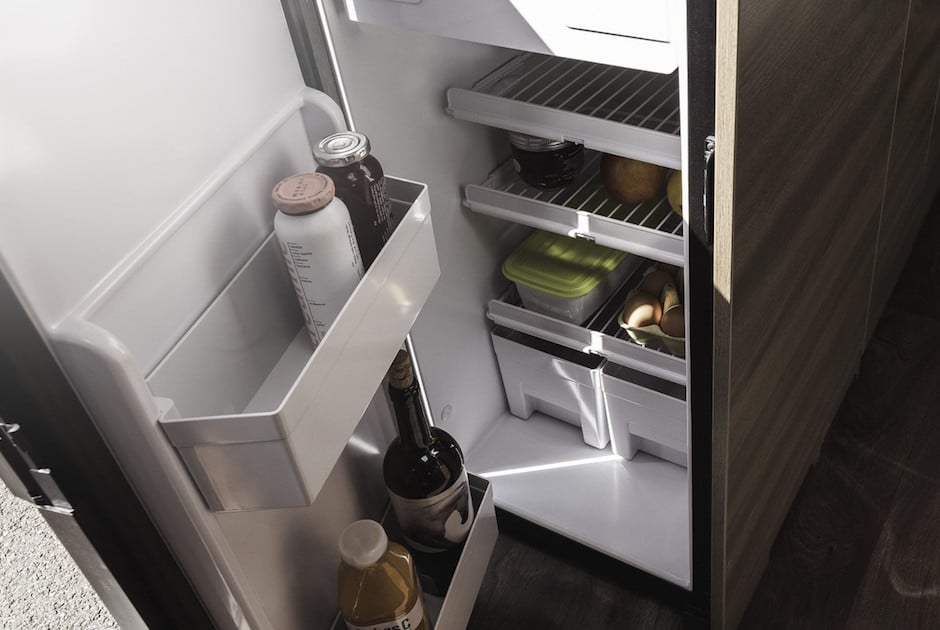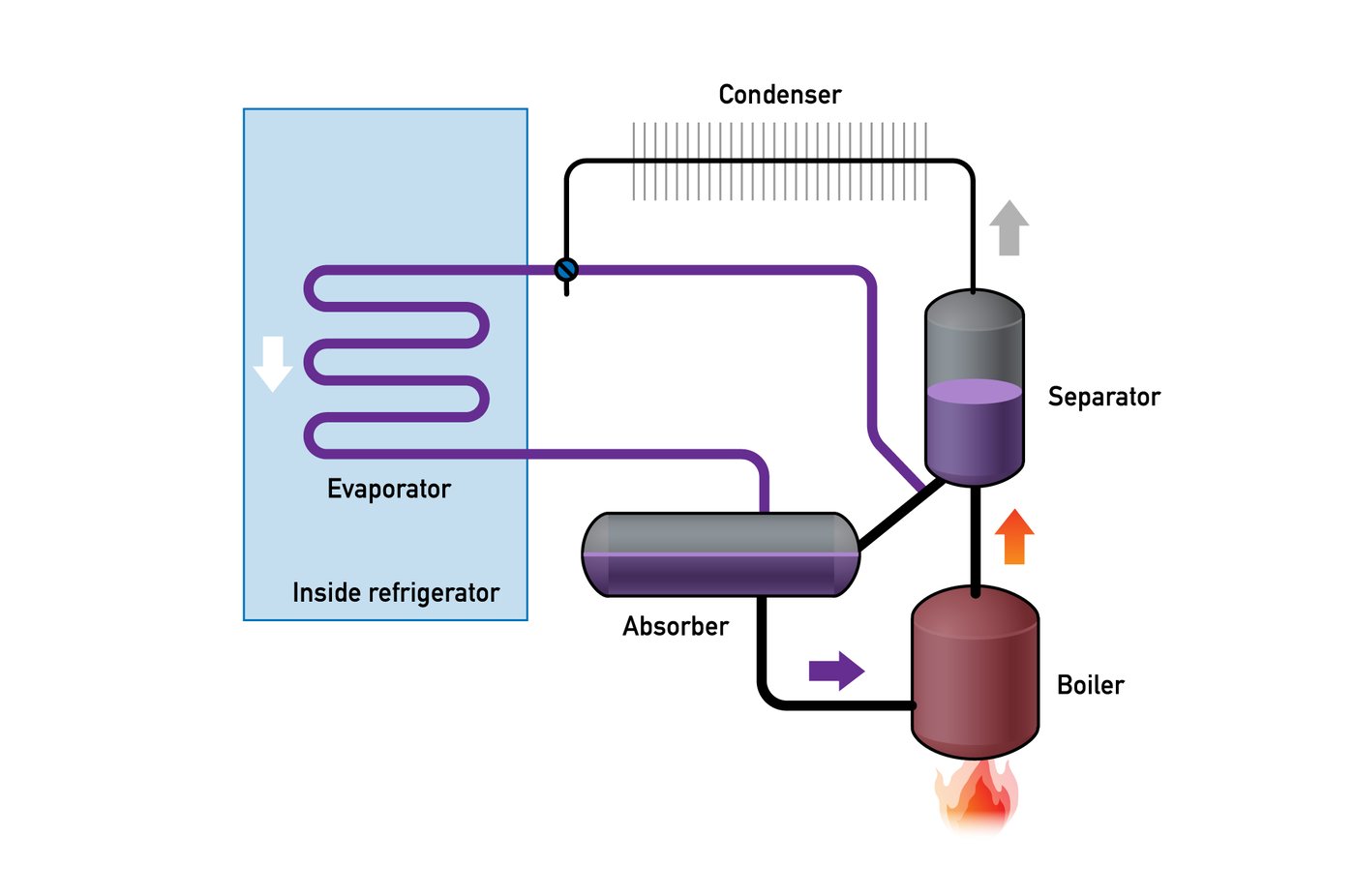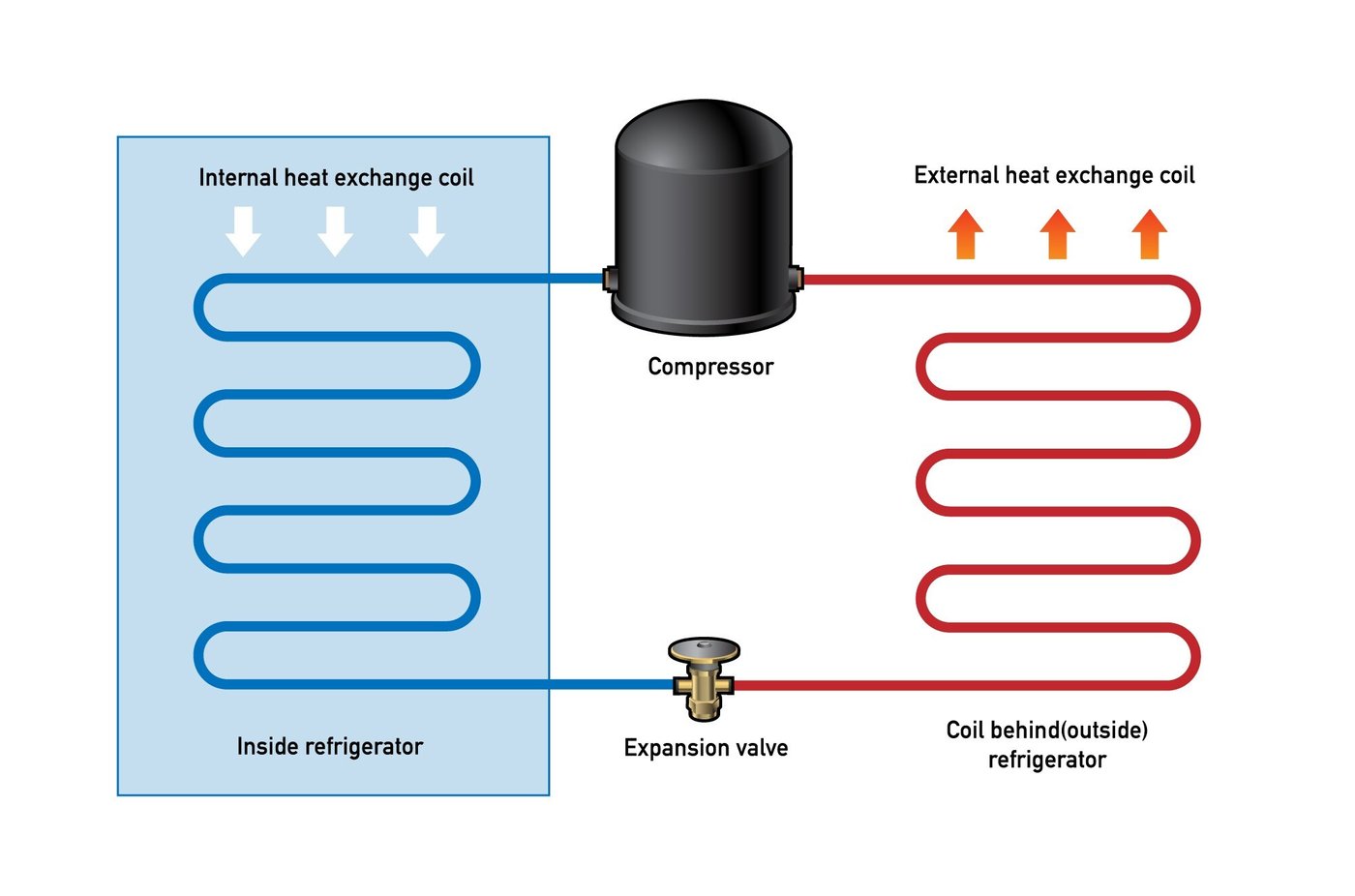
Fridges in RVs — motorhomes, caravans, fifth wheelers and camper trailers — are taken for granted these days. If you’ve been around a while, you’ll remember when an icebox cooler was the only type of refrigeration you could get in a caravan or camper.
Today, a fridge is a vital part of RV travel and even the smallest campers have one. It can be tricky figuring out which type of fridge is best for your RV and your style of camping. Refrigeration becomes complicated as the unit has to:
- Cope with constantly being on the move
- Connect to different energy sources
- Occasionally stay cool without a connection to energy
- Adapt to a wide range of external temperatures.
In this article, we’ll give you the cool facts on different cooling systems and how they work. Absorption (also known as three-way) and compressor are the most common types, while eutectic and thermoelectric are also available in New Zealand. Sounds like a mouthful so let’s delve into what each means.
|
Contents |
What are the different types of RV fridges?
The most common types of fridges in RVs on New Zealand roads are absorption and compressor
Some small campers or off-road vehicles may be kitted out with a thermoelectric or eutectic cooler. Motorhome fridges can run off these three energy sources:
- 240V AC mains power
- 12V DC battery power — from the house battery
- LPG
Upright-style fridges are most common in motorhomes and larger caravans, while many campervans and smaller caravans have more compact under-bench fridges.
Absorption fridges
Absorption fridge technology has been around for about a hundred years — with the first models being commercialised way back in 1920.
Absorption fridges, also known as two-way or three-way fridges, are very common in all types of RVs. They’re usually in the upright style. The term 'three-way' comes from the fact that the fridge can operate on three different energy sources — 240V mains power, 12V and LPG.
If absorption and three-way fridges are new to you, take a look at our glossary of useful terms to know when buying a motorhome.
How an absorption fridge works
 How an absorption fridge works
How an absorption fridge works
An absorption fridge works by heating up a strong ammonia/water solution until it boils. From there, the:
- Boiling solution rises to a separator (in a similar way to a coffee percolator) where the ammonia separates from the water.
- Ammonia rises to pass through a fan-cooled condenser (metal coils with fins) where it becomes liquid again.
- Liquid ammonia then passes through an evaporator where it mixes with hydrogen and passes through tubes in the food storage area, which draws heat from the contents of the fridge.
- Warmed ammonia/hydrogen gases then flow into an absorber (hence the name of the refrigeration process) filled with a weak ammonia solution
- Ammonia is readily absorbed back into the water forming a strong ammonia solution again.
The hydrogen isn’t absorbed, but when separated it returns to the evaporator. The entire cycle then repeats itself.
Compressor fridges
Compressor fridges are also widely used throughout New Zealand. They can operate off 240V mains supply, 12V battery supply, and sometimes 24V DC battery supply.
Compressor fridges have few components and the operating principles behind them are simple enough. As the name suggests, there’s a compressor plus:
- Metal coils that dissipate heat into the air
- An expansion valve that evaporates gas
- Evaporator coils that remove heat from the fridge
- Fridge piping containing a refrigerant (type of gas) that liquefies at low temperatures.
How a compressor fridge works
How a compressor fridge works
The compressor pressurises the refrigerant gas through fan-cooled condenser coils in the open air. From there, the:
- Gas sheds its heat through the coils, condensing into pressurised liquid
- Expansion valve forces the liquid into a low-pressure area created by the suction effect of the compressor
- Liquid vaporises at around -33℃ and drops its temperature
- Suction caused by the compressor pulls this cold gas through the evaporator coils that are inside the food storage area.
This lowers the temperature of the contents and warms the gas, which then passes through the compressor and the cycle continues.
The process of compression and evaporation continues until the fridge temperature reaches its set point. The compressor then only operates when required.
Compressor fridges are available in a number of styles – upright, chest and drawer. Although uncommon, the drawer type is handy for external use in a motorhome or caravan, especially for drinks. The one below is incorporated in an outdoor kitchen in an off-road caravan.

Example of a drawer fridge
Thermoelectric coolers
Thermoelectric coolers are compact and portable making them increasingly popular. While they’re a very handy drink or picnic cooler, they’re not true fridges — at least not in their current stage of development.
The Peltier effect
Thermoelectric coolers operate by the Peltier effect — the electric current from A to B.
When a DC electric current is passed through your device it brings heat from one side to the other, so that one side gets cooler and the other hotter. Whilst that sounds good, thermoelectric coolers are rated to achieve a cooling effect in relation to the ambient temperature. Therefore, they can’t act in the same way that a fridge does.
Thermoelectric coolers are capable of temperatures about 20℃ below the ambient temperature. For example, if:
- The temperature inside your camper is 30℃, your thermoelectric cooler will cool your food and drinks to about 10℃
- Your camper gets up to 40℃ in the sun, you can expect the cooler temperature to be no lower than 20℃.
They don’t have any moving parts but some do have a fan.
How do thermoelectric coolers perform?
For performance, thermoelectric coolers are in their element when you need a small portable cooler that can go almost anywhere and keep most non-perishables cool. However, you’ll definitely need a fridge to chill milk, cheese and meat.
While they’re not suited to keeping perishables cold, thermoelectric coolers have the added bonus of being able to heat food and drinks up to around 65℃.
In summary, thermoelectric coolers are relatively inexpensive but aren’t very efficient.
Eutectic fridges
Eutectic fridges are less common in the RV scene, but are still worth a mention. They use a compressor refrigeration cycle but are constructed differently to compressor fridges.
The evaporator coils, which cool your fridge’s interior, are in a tank that surrounds your food compartment, rather than inside it. This tank contains a liquid that freezes during the refrigeration cycle — cooling the contents of your food storage area.
Once the eutectic liquid freezes, it’ll keep your fridge’s contents cool for an extended period. And that’s one of its advantages — it gets around the noise problem of a compressor cutting in and out overnight.
Which type of RV fridge is better: Absorption or Compressor?
The type of fridge a caravan or motorhome has is likely to be way down your list of must-haves. But if you’re kitting out your own campervan or caravan, or it’s time to replace your existing fridge, you’ll want to know what type is best for you.
Absorption (three-way) and compressor fridges are the most common kinds in RVs in New Zealand, so we’ll weigh up the advantages and disadvantages of each.
Pros of absorption fridges
As highlighted above, absorption fridges can use three different energy sources — mains power, 12V battery power and LPG. Mains power (240V) and LPG are the most efficient. You can hook up to mains in a campground and use LPG when you’re off-the-grid.
Neither of these power sources work when you’re on the road, as gas cylinders must be turned off when driving — and when on a ferry. So motorhomes have a backup 12V power supply to power your fridge and some other functions when mains power or LPG aren’t available.
Read our blog on LPG motorhome safety tips for how to ensure gas safety on the road.
Cons of absorption fridges
Absorption fridges aren’t very efficient when running on 12V compared to compressor fridges, so you may find it drains your house battery quickly. Some fridges have an auto energy selector which automatically detects what energy source you are connected to but others need to be manually switched between sources.
They also don’t cope with high ambient temperatures like those found in Northern Australia. New Zealand temperatures should be fine but check for a T (Tropical) rating when you’re buying a new fridge.
Pros of compressor fridges
Compressor fridges can operate from either 240V mains power or 12V battery power. Following a day’s driving, your 12V compressor refrigerator should easily be able to operate overnight without draining your standard 100Ah battery.
Turning down the thermostat will minimise compressor cycles and therefore reduce your energy consumption.
Cons of compressor fridges
Compressor fridges require adequate battery and solar panel capacity if you’re planning to camp off-the-grid for an extended time.
Some compressor fridges can be a little noisy, especially in comparison to an absorption fridge. If you’re a light sleeper, you may find that the noise from the compressor kicking in may disrupt your sleep, but that depends on the model.
Absorption Fridges |
12V Compression Fridges |
|
Pros:
|
Pros:
|
|
Cons:
|
Cons:
|
How do I keep my RV fridge running efficiently?
Motorhome fridges look after themselves but there are a few simple things you can keep in mind to operate them more efficiently.
- Pre-cool your fridge overnight before heading off on a trip.
Instead of loading your food and drinks into a warm fridge, put them in once the fridge is cool. An RV fridge works hardest when cooling food and drink from room temperature, so give your fridge a helping hand by letting it get cold first. - Pre-chill your food and drink.
Your fridge will also work more efficiently if you put chilled items in it, rather than those that are at room temperature. Buy your drinks from the supermarket chiller as opposed to off the shelf. You’ll reduce the load on your fridge and ensure it operates most efficiently while travelling. Most importantly, you’ll be more confident that your beer or wine will be cold on the first night of your road trip! - Empty and clean your fridge regularly.
To keep your fridge smelling fresh and operating at its best, give it a regular clean out. Check the operating manual for instructions. If you can’t find it, a solution of mild detergent and warm water applied with a soft cloth is fine. Don’t forget the fridge seals. If access to the rear of your fridge is possible, then cleaning dust and dirt off any cooling fins will aid its operation. - Defrost your fridge regularly.
Some fridge models have an auto defrost feature but if yours doesn’t, you’ll need to ensure the frost layer doesn't build up beyond 3mm thick. If it does build up, it’s time to turn your fridge off, clear out the contents, and defrost it. Frost build up reduces airflow within your fridge, making it less efficient. - Fridge seals (and door locks) need to be checked occasionally for air leaks.
Cold air on a warm hand is often a clue. Otherwise, a simple nighttime test is to put a bright torch in the fridge and close the door. If you can’t see the light, you’re all good. If you can, it’s time to closely inspect door locks and seals. - Give your fridge a deep clean prior to storage.
Before putting your RV into storage or closing it up for the winter, give it a deep clean. Then leave the door ajar so air circulates inside when it’s not in use. This will prevent the buildup of mould and other nasties and prevent unpleasant smells. It’s a great idea to run your fridge once a month when it’s in storage so that everything remains oiled and lubricated. Motorhomes with absorption fridges should be stored as level as possible. - Use an Anderson plug connection (for towables).
An Anderson plug is a heavy-duty connector that creates a safe power connection between a caravan or camper and its tow vehicle. Use this connection to maintain a reliable supply between your caravan, camper trailer or fifth wheeler and its tow vehicle. This will reduce the issues of voltage drop between the tow vehicle and the trailer being supplied with 12V power.
|
Fridge cooling tip Your motorhome fridge runs on the 12V house battery while you're driving or enjoying a rest area. If your fridge's temperature starts to creep up, turn on the LPG bottle and switch your fridge to gas mode. This is the most effective way to quickly reduce your fridge's temperature. |
Fridge types supported in New Zealand
The most common compressor and absorption fridges available in New Zealand (Dometic and Thetford) have been well supported by local agents for many years. Dometic also supports Waeco portable compressor fridges.
You can also buy Vitrifrigo, Isotherm and Webasto/IndelB brand fridges from a number of RV and marine suppliers. The suppliers we contacted confirmed that servicing and spare parts are available in New Zealand for these brands.
Before you buy a new fridge, it’s worth checking with the supplier whether the fridge is serviced and supported in New Zealand.
All Wilderness motorhomes come ready-to-cool with a three-way fridge that will run on mains, the 12V house battery and LPG while freedom camping.
Check our comprehensive glossary of useful terms to know when buying a motorhome.
|
Questions about motorhome fridges? If you have any further queries about fridges or coolers, get in touch with one of our team. |




